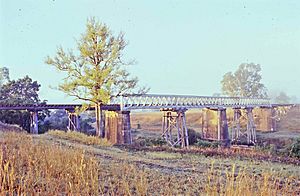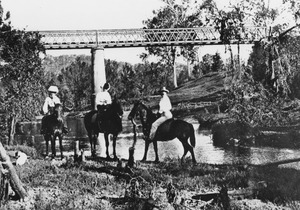Woolooga Rail Bridge facts for kids
Quick facts for kids Woolooga Rail Bridge |
|
|---|---|

Woolooga Rail Bridge
|
|
| Location | Wide Bay Creek on the Theebine - Kilikivan railway line, Woolooga, Gympie Region, Queensland, Australia |
| Design period | 1870s - 1890s (late 19th century) |
| Built | 1884 |
| Official name: Woolooga Rail Bridge | |
| Type | state heritage (built) |
| Designated | 21 October 1992 |
| Reference no. | 600645 |
| Significant period | 1880s, 1930s (fabric) |
| Significant components | pier/s (bridge) |
| Builders | Owen McDermott & Co. |
| Lua error in Module:Location_map at line 420: attempt to index field 'wikibase' (a nil value). | |
The Woolooga Rail Bridge is a special old railway bridge in Woolooga, Queensland, Australia. It crosses Wide Bay Creek and is part of the railway line that goes from Theebine to Kilkivan. This bridge was built a long time ago, in 1884, by a company called Owen McDermott & Co. Because it's an important part of history, it was added to the Queensland Heritage Register in 1992.
Contents
A Look Back: The Bridge's Story
The Woolooga Rail Bridge was built in 1884. It crosses Wide Bay Creek on the railway line that connects Maryborough to Kilkivan.
This railway line, called the Kilkivan branch, was built to help with gold and copper mining in the area. It also helped connect the South Burnett region. The first part of the line opened in 1886. The full line to Kilkivan opened later that year, after a big bridge called the Dickabram Bridge was finished over the Mary River.
The Kilkivan line crossed Wide Bay Creek three times. The company Owen McDermott & Co. was hired in August 1884 to build the whole section to Kilkivan.
Over time, trains became heavier. To allow bigger trains, like the C17 locomotives, to use the bridge, it needed to be made stronger. So, between 1933 and 1935, extra wooden supports (called piers) were added in the middle of each 100-foot section of the bridge. This made the bridge much stronger.
What the Bridge Looks Like
The Woolooga Rail Bridge is also known as Wide Bay No. 2 Crossing Bridge. It has two long sections, each about 100 feet (30 meters) long. These sections are made of metal criss-cross beams, called lattice girders.
The bridge stands on strong concrete supports, called piers. When the bridge was made stronger in the 1930s, new wooden piers were added in the middle of each section, resting on concrete bases.
Why the Bridge is Important
The Woolooga Rail Bridge is listed on the Queensland Heritage Register. This means it is a special historical site that needs to be protected. It was added to the list on October 21, 1992.
Showing Queensland's History
The bridge is important because it shows how Queensland's railway network grew. It also shows how gold and copper mining developed in the Kilkivan area. Railways were very important for moving goods and people in the past.
A Special Type of Bridge
The Woolooga Rail Bridge is a great example of a lattice girder bridge from the 1880s. Even though it has been made stronger with extra supports, it still shows how bridges were built during that time. It's a piece of history that is still being used today!


